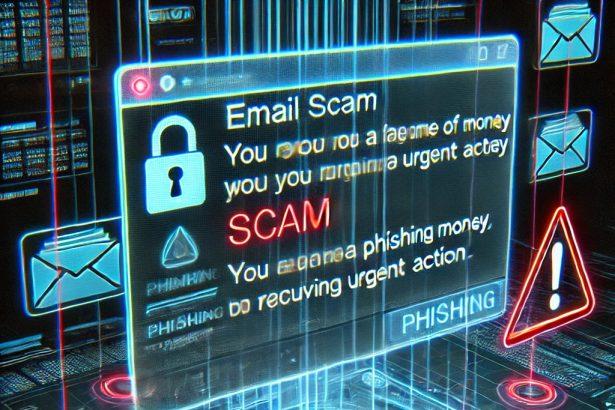Cybercriminals have become increasingly deceptive in their methods to manipulate and extort internet users. One such disturbing trend is the “We Hacked Your System” sextortion email scam—a fraudulent message that attempts to extort victims by claiming their devices were hacked and explicit footage was recorded without consent. Despite the frightening tone and threatening language, this scam is a complete fabrication, crafted purely to exploit fear and shame.
What is the “We Hacked Your System” Email Scam?
The “We Hacked Your System” email is a sextortion scam that alleges the sender has compromised the recipient’s computer using a Trojan virus. The message claims that the malware was delivered when the recipient visited an adult website, giving hackers full access to the victim’s screen, webcam, microphone, and files.
To create panic, the scammer claims to have made an explicit video showing the recipient watching adult content and demands $1300 in Bitcoin within 50 hours. If the demand is not met, the alleged footage will be distributed to the recipient’s contacts via email, social networks, and messengers.
Important: None of the claims in this email are true. No device has been infected, no footage exists, and no contacts will be messaged. It is a common tactic used in social engineering schemes.
Full Text of the Scam Email
Consider this message as your last warning.
We hacked your system!
We have copied all the data from your device to our own servers.
Curious videos were recorded from your camera and your actions while watching porn.
Your device was infected with our virus when you visited the porn site.
The Trojan virus gives us full access, allows us to control your device.
The virus allows not only to see your screen, but also to turn on your camera, microphone, without your knowledge.
We took over the video from your screen and camera, then we mounted a video in which you can see you watching porn in one part of the screen and masturbating in the other.
But that’s not all! We have access to all the contacts in your phone book and social networks.
It won’t take us long to send this video to your friends, family and friends on social networks, messengers and email in minutes.
We have a lot of audio recordings of your personal conversations, where a lot of “interesting” things are revealed!
This information can destroy your reputation once and for all in a matter of minutes.
You have an opportunity to prevent irreversible consequences.
To do this:
Transfer 1300 $ USD (US dollars) to our bitcoin wallet.
Don’t know how to make a transfer? Enter the query “Buy bitcoins” into the search field.
Our bitcoin wallet bc1qj2aesryeq0yhg6ntk4s8n2sssgtpde4a2jt5eq
After making the payment, your video and audio recordings will be completely destroyed and you can be 100% sure that we won’t bother you again.
You have time to think about it and make the transfer – 50 hours!
After you read this letter, we will get an automatic notification. From that moment on, the timer will start.
It is useless to complain, because bitcoin-wallets cannot be tracked, as well as the mail from which the letter arrived to you.
We also do not advise you to send this letter to anybody.
In this case the system will automatically send a request to the server, and all data will be published in social networks and messengers.
You will not be able to solve the problem by changing passwords in social networks, as all the information is already downloaded to the cluster of our servers.
Think about what your reputation means to you and how much the consequences will be.
You have 50 hours.
Threat Summary
| Category | Details |
|---|---|
| Threat Name | “We Hacked Your System” Sextortion Scam |
| Threat Type | Phishing, Scam, Sextortion, Social Engineering |
| Associated Email(s) | Varies by campaign; typically spoofed or fake addresses |
| Fake Claims | Device hacked, explicit video recorded, contacts accessed |
| Cryptowallet Address | bc1qj2aesryeq0yhg6ntk4s8n2sssgtpde4a2jt5eq |
| Symptoms of Infection | None – no actual infection, all claims are false |
| Damage Potential | Monetary loss (if paid), emotional distress, reputation anxiety |
| Distribution Methods | Spam email, rogue pop-ups, misspelled domains, SEO poisoning |
| Danger Level | Medium (psychological manipulation), Low (no real malware involved) |
| Detection Names | Not applicable (scam, not malware), but may be flagged by phishing filters |
How to Manually Identify and Remove Email Scams
Manually removing email scams involves recognizing fraudulent messages, securing your accounts, and taking precautions to prevent future attacks. Follow these steps:
Step 1: Identify Suspicious Emails
Before taking action, you need to identify scam emails. Common signs include:
- Unknown Sender: Emails from unfamiliar addresses, especially if they claim to be from banks, tech support, or government agencies.
- Urgency or Threats: Scammers often pressure you to act immediately (e.g., “Your account will be closed in 24 hours!”).
- Poor Grammar & Spelling: Many scam emails contain obvious grammatical mistakes.
- Suspicious Links & Attachments: Hover over links (without clicking) to check the actual URL. If it looks odd, don’t click.
- Requests for Personal Information: Legitimate companies will never ask for passwords, Social Security numbers, or credit card details via email.
Step 2: Do Not Click Links or Download Attachments
If you suspect an email is a scam:
- Do not click on any links.
- Do not open any attachments.
- Do not reply to the sender.
Step 3: Report the Email Scam
You can report the scam email to various authorities:
- Gmail/Outlook/Yahoo Users: Click the “Report Phishing” or “Report Spam” button in your email client.
- FTC (Federal Trade Commission, USA): Report to FTC Complaint Assistant.
- Google Safe Browsing: If the scam email contains a phishing website, report it here.
Step 4: Block the Sender
- Gmail: Open the email, click the three dots in the top-right corner, and select “Block [Sender Name]”.
- Outlook: Open the email, select “Junk” > “Block Sender”.
- Yahoo Mail: Open the email, click “More” > “Block Sender”.
Step 5: Check Your Accounts for Unauthorized Activity
If you accidentally clicked a link or shared sensitive information:
- Change your passwords immediately. Use strong, unique passwords for every account.
- Enable two-factor authentication (2FA). This adds an extra layer of security to your accounts.
- Check your banking statements for unauthorized transactions.
Step 6: Scan Your Device for Malware
Some email scams contain malware hidden in attachments or malicious links. Run a full system scan using built-in tools:
- Windows Defender (Windows 10/11):
- Go to Settings > Update & Security > Windows Security > Virus & Threat Protection.
- Click “Quick Scan” or “Full Scan”.
- Mac Users:
- Use Malwarebytes for Mac or another security tool.
Step 7: Adjust Your Email Security Settings
- Enable email filtering to reduce spam and phishing emails.
- Add a third-party spam filter such as Mailwasher or Spamihilator.
- Educate yourself and others on phishing techniques to avoid future scams.
How to Remove Email Scams Using SpyHunter (Automated Method)
For users who prefer an automated, foolproof method to remove threats linked to email scams, SpyHunter offers an advanced security solution. SpyHunter is an anti-malware tool designed to detect and remove phishing-related threats, spyware, Trojans, and other cyber threats. Follow these steps:
Step 1: Download SpyHunter
- Visit the official SpyHunter download page: Download SpyHunter
- Click on “Download” and save the installation file to your computer.
Step 2: Install SpyHunter
- Locate the downloaded file (SpyHunter-Installer.exe) and double-click to open it.
- Follow the on-screen installation instructions.
- After installation, launch SpyHunter.
Step 3: Perform a Full System Scan
- Open SpyHunter and navigate to “Malware/PC Scan”.
- Click “Start Scan Now” to begin a deep scan of your system.
- SpyHunter will analyze files, registry entries, and processes for any threats linked to email scams, phishing, and malware.
Step 4: Review and Remove Detected Threats
- Once the scan completes, SpyHunter will list all detected threats.
- Click "Fix Threats" to remove them.
- Restart your computer to complete the removal process.
Step 5: Enable Real-Time Protection
SpyHunter includes real-time protection features to help prevent future infections:
- Enable Active Guards: This monitors your system for malware in real time.
- Schedule Automatic Scans: Set up periodic scans to detect new threats early.
Step 6: Keep SpyHunter Updated
- Regularly check for updates to ensure SpyHunter detects the latest threats.
- To update SpyHunter, open the app and go to "Settings" > "Update", then click "Check for Updates".
Preventing Future Email Scams
Now that you've removed email scams, take proactive steps to prevent them in the future:
Use a Secure Email Provider
- Consider switching to a secure email provider like ProtonMail or Tutanota, which offer advanced encryption.
Be Cautious with Email Links
- If you receive an email with a suspicious link, verify the website’s legitimacy before clicking.
Avoid Public Wi-Fi for Sensitive Activities
- Scammers can use public Wi-Fi to intercept your data. Use a VPN when accessing email on public networks.
Regularly Change Your Passwords
- Update your passwords every few months, and never reuse old passwords.
Use Anti-Phishing Extensions
- Install browser extensions like Bitdefender TrafficLight or Avast Online Security to detect phishing links in real-time.
Email scams are a serious cyber threat that can lead to financial loss, identity theft, or malware infections. By following the manual removal steps, you can effectively identify and remove suspicious emails on your own. However, for advanced protection, using SpyHunter ensures a more thorough and automated approach to detecting and removing phishing-related threats.
Recommended Action
For a fast and efficient way to remove email scams and related malware, download and install SpyHunter now: Download SpyHunter
By staying informed and proactive, you can protect yourself from future email scams and online threats!
Conclusion
While the “We Hacked Your System” email may appear threatening, it is crucial to remember that it is a hoax designed to exploit fear. Never pay the ransom or engage with the sender. Instead, mark the email as spam and delete it.




